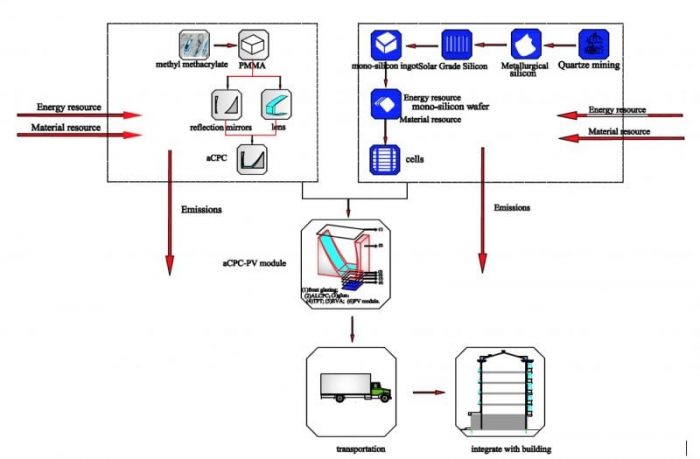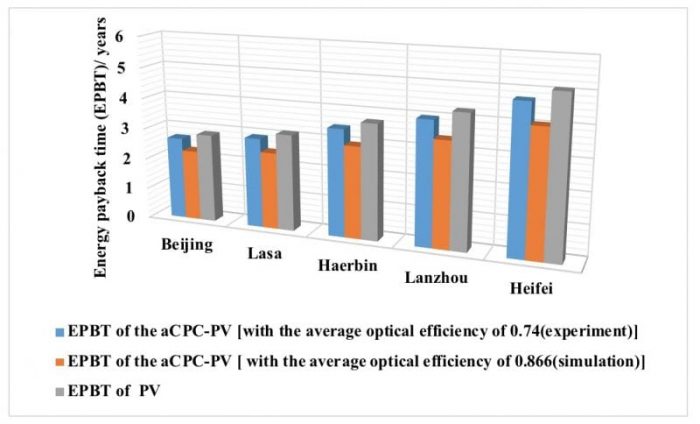
Low-concentration PV technology is an interesting concept because it can work as a static concentrator without any tracking systems or seasonal adjustments, showing potential benefits of introducing the CPV or CPV/T (Concentrating Photovoltaic/Thermal) systems for building applications.
Besides that, it can reduce the PV cells in exchange for a low-cost PMMA material for the same or even higher output and harvest a higher temperature energy resource as well. However, due to the continuing decrease in the cost of the PV cells and increase in their efficiency, the cost and performance advantages of the large-scale application of the low-concentration PV technology seems to be weakening.
Researchers from the University of Science and Technology of China conducted a life cycle assessment of the low-concentration PV technology for building south wall integration in China to quantify the environmental impacts of it during the entire lifecycle.
The functional unit of the studied module was 1 kWp electricity supply, and the system boundary is shown in Fig. 1, which ranges from silica extraction to the cell manufacture and the production of the concentrator, which includes the production processes from the polymerization reaction of the MMA to the silver coating of the reflection mirrors as well as the assembling of the low-concentration PV module and the transportation of the module from the factory to the buildings.

Fig.1. Life cycle of the low concentration-PV module. (Image credit: Guiqiang Li)
EPBTs (Energy Payback Time) of the low-concentration PV module (with the experimental/simulation optical efficiency) and PV systems (for 1kWp) for five different cities in China (Lhasa (91.11°E, 29.97°N), Hefei (117.27°E, 31.86°N), Lanzhou (103.73°E, 36.03°N), Beijing (116.46°E, 39.92°N), Harbin (126.63°E, 45.75°N)) are shown in Fig. 2. From the results, it can be seen that Beijing has the lowest EPBT (2.82 years, experimental optical efficiency) while Hefei has the highest EPBT (4.74 years, experimental optical efficiency).
This is related to the highest low concentration PV output in Beijing and lowest in Hefei. While with the simulation optical efficiency, the EPBTs of five cities are around 0.5 years lower than that with the experimental optical efficiency. On the other hand, even with the experimental optical efficiency, EPBTs of the CPV system are always 0.2-0.3 years lower that of the PV system with the same total output.

Fig. 2 Energy payback time of the low concentration PV module and the normal PV module. (Image credit: Guiqiang Li)
A detailed comparison of the environmental impacts for the low-concentration PV module with that of the PV module with the same output is listed in Table 1. From the results, it can be clearly seen that the inventory categories that are selected to study the environmental profile, such as AP (Acidification Potential), GWP (Global Warming Potential), EP (Eutrophication Potential), HTP (Human Toxicity Potential), ODP (Ozone Layer Depletion Potential), or POCP (Photochemical Ozone Creation Potential), of the low-concentration PV module are all relatively lower than that of the PV module with the same output for the building south wall integration. So the superiorities of the low concentration PV module, in terms of the price, EPBT and environment impacts are obvious as compared with the PV module.
From the LCA study, it can be concluded that the low-concentration PV technology is still more environmentally friendly regarding the aspects of a clean energy resource as well as creating less pollution and energy demand during the production process, thus protecting the global environment. Therefore, it deserves a wider scope of application to cover the building energy demand.
| LCIA category | aCPC-PV module (per Wp) | PV module (Wp) |
| Acidification Potential/kg SO2-Eq. | 9.16×10-3 | 1.04×10-2 |
| Global Warming Potential (100 years)/kg CO2-Eq. | 1.09 | 1.24 |
| Eutrophication Potential/kg Phosphate-Eq. | 9.07×10-4 | 1.03×10-3 |
| Human Toxicity Potential /kg DCB-Eq. | 0.38 | 0.43 |
| Ozone Layer Depletion Potential /kg R11-Eq. | 6.47×10-8 | 7.35×10-8 |
| Photochemical Ozone Creation Potential /kg Ethene-Eq. | 5.77×10-4 | 6.55×10-4 |
Table 1: Comparison of the environmental impacts of the low concentration PV module with that of the PV module with the same output.
These findings are described in the article entitled Life-cycle assessment of a low-concentration PV module for building south wall integration in China, recently published in the journal Applied Energy. This work was conducted by Guiqiang Li and Qingdong Xuan, et al. from the University of Science and Technology of China.









